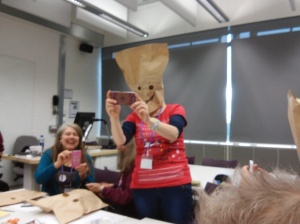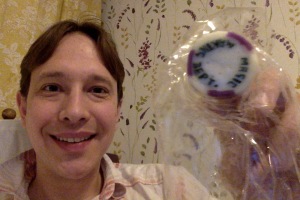This is the final part of School Librarians Revealed, a report on the joint SCBWI-BI Central East Region/Ipswich Children’s Book Group meeting with two Suffolk school librarians: Jayne Gould and Alison Baker.
Authors are Real People: The Secrets of School Visits
Children really love to have authors come into school and often feel that they are meeting “a famous person”. So it’s not surprise publishers are very keen to have authors come into school or go on tour. Pupils find writing workshops very good and are always interested in hearing how writers go about writing, for example, Jeremy Strong talks about his writing shed.
When writers come into school they need to be able to “hold” a class and talk to them. Often the best authors have some sort of show, do something special and sparkle. But authors don’t need to be all singing all dancing. Douglas Hill, for example, had a very quiet presence and delivery, but still held the children with the story he told.
“The 2 Steves” – Barlow and Skidmore (www.the2steves.net) – are cited as an example that all writers can learn from because of their skill at holding a class, learned from years of teaching drama. Jack Trelawney is also good.
School visits also help facilitate it the relationship between writers and readers. It’s good for children to recognise the writers are “real people”. Many students don’t realise that you can write to authors and children are delighted to meet them. Authors are encouraged to make use of any connection they already have with a school — especially if they had previously worked there or have children at that school.
Writer should have a plan and know what they are going to talk about or do. If the children are misbehaving author shouldn’t be afraid to make them pay attention rather than waiting for teachers or librarians to intervene. Anne Cassidy told off three girls at the back of an audience of 100 for talking and the students were far more shocked at being picked out by the author than they would have been being told off by a teacher.
Authors also need to be flexible and adaptable. “Don’t panic when things go off plan, just go with the flow,” suggest Allison, “and the children will respond.” Keep an eye on the audience – if you’re losing their interest, wind things up quickly.
Schools are also an excellent place to get feedback from young readers, if you’re brave enough! Children can be extremely honest about their opinion of books. Only the flip side, authors can end up leaving the school with lots of new ideas generated by the pupils.
Best Books of Last Year
As part of our discussion we talked about what everyone in the audience and on the panel thought were the best books published last year or once there are most excited about when they read them.
· All three of the Charlie Fletcher books — about statues coming to life in London: Stoneheart, Ironhand and Silvertongue.
· Gideon the Cutpurse by Linda Buckley-Archer – the third instalment is hotly anticipated!
· The final book of the Noughts and Crosses Trilogy – Checkmate by Malorie Blackman
· Skulduggery Pleasant by Derek Landy. It was considered a big book to get into, but it was a nice story and a good adventure that attracted a wide range of readers in the school libraries. Interestingly, it genuinely crossed the gender divide because girls like Valkyrie Cain and boys like Skulduggery.
Favourite books
The Dragonfly Pool by Eva Ibbotson is regarded as a modern classic. Many librarians felt they could constantly give it to any child who could read and that they know that there isn’t anything bad to take from it, but a good story.
The Penderwicks by Jeanne Birdsal (www.jeannebirdsall.com) is very highly thought of by Jayne, but had not had much success yet selling it to students.
The London Eye Mystery by the late Siobhan Dowd was very popular with year four onwards at Broke Hall School.
Alison felt he couldn’t go wrong Michael Morpurgo.
Mrs Marriage Project by Pauline Fisk — this book caught the imagination of one librarian, but she couldn’t sell it to most of the girls in her school.
One important consideration for book is its ability to be read out in class by a teacher.
Children don’t seem to be aware or snobbish of abridgements or adaptations. 50 page versions of Dickens are popular, and often the children will come back to the longer versions if they want to later on.
Boy Books and Girl Books
Authors that bridge the gender divide
· Robert Muchamore
· Roald Dahl
· Michael Murporgo
· JK Rowling
Books that bridge the gender divide
· Horrid Henry by Francesca Simon and Tony Ross
· Skulduggery Pleasant by Derek Landy
· London Eye Mystery by Siobhan Dowd
· Percy Jackson by Rick Riordan (very popular with year six)
· Vampirates by Justin Somper
· The Series of Unfortunate Events by Lemony Snickett
· The Roman Mysteries by Caroline Laurence
· Spiderwick Chronicles by Holly Black and Tony DiTerlizzi
There are obviously many books that would definitely are boy read or girl reads. One librarian had tried very hard to persuade boys to read “Not Quite a Mermaid”, but could not overcome the pink cover. During a session on choosing books, Not Quite a Mermaid was a definite no when judged by the cover, it became a probably not when the blurb was read out, but, after being read the beginning of the story the boys were interested in it, but would not borrowed because of the pink cover.
And, Finally….
Jayne had a very interesting exercise with some of her year six pupils to help them break away for what they normally read and to read something different. She selected books for each of the pupils and put them in an envelope which they were not allowed to open until they were back in the classroom. They were told to have a go at the book and to come back and talk about it. The pupils were excited by the exercise and it worked very well.
I’d like to thank Jayne Gould and Alison Baker as well as everyone who attended the discussion at Broke Hall School. I’m also very grateful to the school for allowing us to have our meeting their with the Ipswich Children’s Book Group. You can find out more about British SCBWI by visiting http://britishscbwi.jimdo.com/









